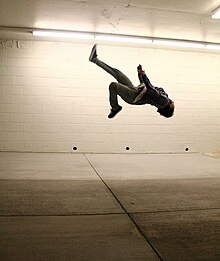
A kick is a physical strike using the leg, in unison usually with an area of the knee or lower using the foot, heel, tibia (shin), ball of the foot, blade of the foot, toes or knee. This type of attack is used frequently by hooved animals as well as humans in the context of stand-up fighting. Kicks play a significant role in many forms of martial arts, such as capoeira, kalaripayattu, karate, kickboxing, kung fu, MMA, Muay Thai, pankration, pradal serey, savate, sikaran, silat, taekwondo, vovinam, and Yaw-Yan. Kicks are a universal act of aggression among humans.

Martial arts are codified systems and traditions of combat practiced for a number of reasons such as self-defence; military and law enforcement applications; competition; physical, mental, and spiritual development; entertainment; and the preservation of a nation's intangible cultural heritage.

Taekwondo, also spelled tae kwon do or taekwon-do, is a Korean martial art and combat sport involving punching and kicking techniques. The literal translation for taekwondo is "kicking", "punching", and "the art or way of". It sometimes involves the use of weapons.
Hapkido is a Korean hybrid martial art. It is a form of self-defense that employs joint locks, grappling, throwing techniques, kicks, punches, and other striking attacks. It also teaches the use of traditional weapons, including knife, sword, rope, nunchaku, cane, short stick, and middle-length staff, gun, and bō (Japanese), which vary in emphasis depending on the particular tradition examined.

A strike is a directed, forceful physical attack with either a part of the human body or with a handheld object, intended to cause blunt or penetrating trauma upon an opponent.

Taekkyon,Taekgyeon, Taekkyeon, or Taekyun is a traditional Korean martial art.

The front kick in martial arts is a kick executed by lifting the knee straight forward, while keeping the foot and shin either hanging freely or pulled to the hip, and then straightening the leg in front of the practitioner and striking the target area. It is desirable to retract the leg immediately after delivering the kick, to avoid the opponent trying to grapple the leg and to return to stable fighting stance.

In martial arts and tricking, the 540 kick is a jump kick move. It involves a rotation of approximately 540 degrees.

A butterfly kick or horse kick is a jumping kick in martial arts such as modern wushu, taekwondo and capoeira. In certain changquan styles, this kick is known as Swallow Kick.

Kata is a Japanese word meaning "form". It refers to a detailed choreographed pattern of martial arts movements made to be practiced alone. It can also be reviewed within groups and in unison when training. It is practiced in Japanese martial arts as a way to memorize and perfect the movements being executed. Korean martial arts with Japanese influence use the derived term hyeong and also the term pumsae.

A roundhouse kick is a kick in which the practitioner lifts the knee while turning the supporting foot and body in a semicircular motion, extending the leg striking with the lower part of the shin and/or the instep. The ball of the foot can also be used to strike the target and is preferable when power breaking thick boards. This type of kick is utilized in many different martial arts and is popular in both non-contact and full-contact martial arts competitions. The kick has many variations based on stance, leg movement, striking surface, and the height of the kick.
An aerial twist is an acrobatic flip that incorporates a 180° rotation during the peak of the flip's height. Gymnasts normally perform the twisting with the legs together to obtain a faster spin and more aesthetically pleasing execution. Tricksters normally perform the twisting with the legs apart; mainly for style. Many martial arts tricksters first learning this move have a tendency to begin more like a butterfly twist than an aerial. In the tricking community, this move can be done from either a running start, a small hop skip, standing, or from another trick in a combo.
A Double Leg is a move that originated from Capoeira but was incorporated into tricking like many other martial arts moves because of its difficulty and aesthetics. Its Capoeira name is Armada Dupla, which means a double armada. An Armada is the capoeira version of a Reverse Roundhouse kick. The distinguishing feature of this move is the fact that both legs remain together during the take off and execution; its name is derived from this feature. After the take off, the torso stays upright and vertical, but will begin to quickly torque in order to swing the legs around and upwards. At the peak of this move, the body is in the shape of a "V". The legs continue to swing over as the body straightens out for the landing.

A jump kick is a type of kick in certain martial arts and in martial-arts based gymnastics, with the particularity that the kick is delivered mid-air, specifically moving ("flying") into the target after a running start to gain forward momentum. In this sense, a "Jump kick" is a special case of a flying kick, any kick delivered in mid-air, i.e. with neither foot touching the ground.
This is a general glossary of the terms used in the sport of gymnastics.
Yongmudo, Yongmoodo or Yong Moo Do is a modern hybrid Korean martial art which combines different techniques from taekwondo, hapkido, judo, and ssireum as well as boxing and wrestling.

Tae Bo is a body fitness system that incorporates martial arts techniques, such as kicks and punches, which became popular in the 1990s. It was developed by American taekwondo practitioner Billy Blanks. Such programs use the motions of martial arts at a rapid pace designed to promote fitness.













